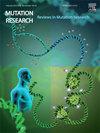E2F1 activates USP19 to affect the stability of c-Myc to facilitate the progression of hepatocellular carcinoma
IF 1.5
4区 医学
Q4 BIOTECHNOLOGY & APPLIED MICROBIOLOGY
Mutation Research-Fundamental and Molecular Mechanisms of Mutagenesis
Pub Date : 2025-01-01
DOI:10.1016/j.mrfmmm.2025.111902
引用次数: 0
Abstract
Background
Hepatocellular carcinoma (HCC) is the most common malignant tumor worldwide with a high mortality rate. Herein, this study aims to explore the molecular mechanisms of E2F transcription factor 1 (E2F1), ubiquitin specific peptidase 19 (USP19) and c-Myc in regulating HCC progression.
Methods
RT-qPCR and western blotting were utilized to assess mRNA and protein expression, respectively. The behavior of cells was examined through Methylthiazolyldiphenyl-tetrazolium bromide (MTT), flow cytometry, transwell, and cell sphere formation assays. Glycolysis-related indicators were detected by kits. The interaction between USP19 and c-Myc was measured by co-immunoprecipitation (Co-IP). Dual-luciferase reporter assay and Chromatin Immunoprecipitation (ChIP) assays were used to assess the binding of E2F1 and USP19 promoter. A mouse xenograft model was established for the purpose of analysis in vivo.
Results
High level of c-Myc was observed in HCC tissues and cells. Silencing c-Myc results in the suppression of cell migration, invasion, proliferation, and glycolysis or promotion of apoptosis. USP19 directly bound to c-Myc, and maintained its stability by removing ubiquitination on c-Myc. Overexpression of c-Myc in HCC cells rescued the anti-tumor effect of USP19 deletion. E2F1 promoted USP19 transcription, and increased USP19 expression counteracts the effects of E2F1 depletion on cell behaviors. In vivo, USP19 knockdown controlled HCC growth by modulating c-Myc.
Conclusion
E2F1 activated USP19 transcription, thereby stabilizing c-Myc via deubiquitination and accelerating HCC progression.
E2F1激活USP19影响c-Myc的稳定性,促进肝细胞癌的进展
背景肝细胞癌(HCC)是世界范围内最常见的恶性肿瘤,死亡率高。本研究旨在探讨E2F转录因子1 (E2F1)、泛素特异性肽酶19 (USP19)和c-Myc调控HCC进展的分子机制。方法采用srt - qpcr和western blotting分别检测mRNA和蛋白的表达。通过甲基噻唑基二苯基四唑溴化铵(MTT)、流式细胞术、transwell和细胞球形成实验来检测细胞的行为。采用试剂盒检测糖酵解相关指标。USP19与c-Myc的相互作用通过共免疫沉淀(Co-IP)测定。采用双荧光素酶报告试验和染色质免疫沉淀(ChIP)试验评估E2F1与USP19启动子的结合。建立小鼠异种移植物模型,进行体内分析。结果肝癌组织和细胞中可见高水平的c-Myc。沉默c-Myc可抑制细胞迁移、侵袭、增殖、糖酵解或促进细胞凋亡。USP19直接与c-Myc结合,并通过去除c-Myc上的泛素化来维持其稳定性。HCC细胞中c-Myc的过表达恢复了USP19缺失的抗肿瘤作用。E2F1促进了USP19的转录,USP19表达的增加抵消了E2F1缺失对细胞行为的影响。在体内,USP19敲低通过调节c-Myc来控制HCC的生长。结论e2f1激活USP19转录,通过去泛素化稳定c-Myc,加速HCC进展。
本文章由计算机程序翻译,如有差异,请以英文原文为准。
求助全文
约1分钟内获得全文
求助全文
来源期刊
CiteScore
4.90
自引率
0.00%
发文量
24
审稿时长
51 days
期刊介绍:
Mutation Research (MR) provides a platform for publishing all aspects of DNA mutations and epimutations, from basic evolutionary aspects to translational applications in genetic and epigenetic diagnostics and therapy. Mutations are defined as all possible alterations in DNA sequence and sequence organization, from point mutations to genome structural variation, chromosomal aberrations and aneuploidy. Epimutations are defined as alterations in the epigenome, i.e., changes in DNA methylation, histone modification and small regulatory RNAs.
MR publishes articles in the following areas:
Of special interest are basic mechanisms through which DNA damage and mutations impact development and differentiation, stem cell biology and cell fate in general, including various forms of cell death and cellular senescence.
The study of genome instability in human molecular epidemiology and in relation to complex phenotypes, such as human disease, is considered a growing area of importance.
Mechanisms of (epi)mutation induction, for example, during DNA repair, replication or recombination; novel methods of (epi)mutation detection, with a focus on ultra-high-throughput sequencing.
Landscape of somatic mutations and epimutations in cancer and aging.
Role of de novo mutations in human disease and aging; mutations in population genomics.
Interactions between mutations and epimutations.
The role of epimutations in chromatin structure and function.
Mitochondrial DNA mutations and their consequences in terms of human disease and aging.
Novel ways to generate mutations and epimutations in cell lines and animal models.

 求助内容:
求助内容: 应助结果提醒方式:
应助结果提醒方式:


